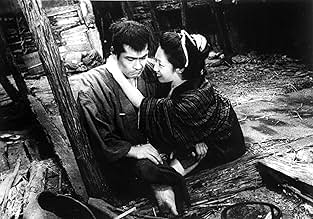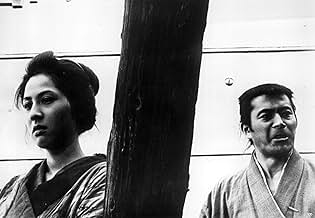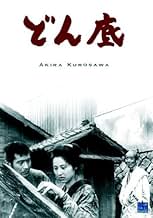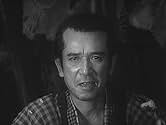NOTE IMDb
7,2/10
6,2 k
MA NOTE
Ajouter une intrigue dans votre langueIn a Japanese slum, various residents play out their lives, dreaming of better things or settling for their lot. Among them is a man who pines for a young woman but is stymied by her decepti... Tout lireIn a Japanese slum, various residents play out their lives, dreaming of better things or settling for their lot. Among them is a man who pines for a young woman but is stymied by her deceptive family.In a Japanese slum, various residents play out their lives, dreaming of better things or settling for their lot. Among them is a man who pines for a young woman but is stymied by her deceptive family.
- Réalisation
- Scénario
- Casting principal
- Récompenses
- 5 victoires au total
Kamayuki Tsubono
- Tradesman
- (non crédité)
Avis à la une
I enjoyed it. Everyone in the movie has very distinct character. I really enjoyed the superb performances of skilled actors who acted without going out from the dirty room and surrounding area.
After watching the movie, I read its original stage drama, "The Lower Depth" by Gorky. Most of the characters and the scripts are the same as the original drama. On Gorky's book, I could not help reading it with exact accent and gesture in the movie. Particularly, I can't imagine better way of speaking the pilgrimage Luke's scripts than Kahei acted by Hidari Bokuzen. I am sure the scripts of the movie are based on Nakamura Hakuyo's Japanese translation published from Iwanami. Even the Russian stage drama is adapted to completely different locale, you don't feel any awkwardness. This means perhaps, both the original drama and its adaptation are really great.
What only a movie could do is that you can enjoy subtle expression of countenance at close up. There are unforgettable performances by face, such as the moment of instant tension when the land owner, acted by Nakamura Ganjiro, and Sutekichi the thief, acted by Mifune Toshiro, stand together; or the moment the actor, acted by Fujiwara Kamatari, goes out of the house after gulping sake.
The scene of dancing with mouth instrumentation ('kuchi-syamisen in Japanese) is a great fun. Particularly I enjoyed the fat man Tsugaru dancing with sling; I found the actor is a professional sumo wrestler.
The most unforgettable personality is the old man Kahei. Can I become such a nice old man who can solace and encourage everyone around me? This movie can work out without Sutekichi the thief, but the old man. Therefore, the old man Kahei could be the lead character.
By the way, as a movie that describes the lower depth life with humor and music, I remember "Woman of Breakwater", by Philippine director Mario O'Hara. People in "Woman of Breakwater" came to live outside of the breakwater of Manila Bay. Everyone wants to flee from there, but can not. Just behind the breakwater is a park, and modern buildings. Describing the life of the poor out of the sight of the rich, it portrays mutual love among the people. "Donzoko" does not have such social viewpoint. Instead, it tries to show ugliness and kindness of everyone as a comedy.
After watching the movie, I read its original stage drama, "The Lower Depth" by Gorky. Most of the characters and the scripts are the same as the original drama. On Gorky's book, I could not help reading it with exact accent and gesture in the movie. Particularly, I can't imagine better way of speaking the pilgrimage Luke's scripts than Kahei acted by Hidari Bokuzen. I am sure the scripts of the movie are based on Nakamura Hakuyo's Japanese translation published from Iwanami. Even the Russian stage drama is adapted to completely different locale, you don't feel any awkwardness. This means perhaps, both the original drama and its adaptation are really great.
What only a movie could do is that you can enjoy subtle expression of countenance at close up. There are unforgettable performances by face, such as the moment of instant tension when the land owner, acted by Nakamura Ganjiro, and Sutekichi the thief, acted by Mifune Toshiro, stand together; or the moment the actor, acted by Fujiwara Kamatari, goes out of the house after gulping sake.
The scene of dancing with mouth instrumentation ('kuchi-syamisen in Japanese) is a great fun. Particularly I enjoyed the fat man Tsugaru dancing with sling; I found the actor is a professional sumo wrestler.
The most unforgettable personality is the old man Kahei. Can I become such a nice old man who can solace and encourage everyone around me? This movie can work out without Sutekichi the thief, but the old man. Therefore, the old man Kahei could be the lead character.
By the way, as a movie that describes the lower depth life with humor and music, I remember "Woman of Breakwater", by Philippine director Mario O'Hara. People in "Woman of Breakwater" came to live outside of the breakwater of Manila Bay. Everyone wants to flee from there, but can not. Just behind the breakwater is a park, and modern buildings. Describing the life of the poor out of the sight of the rich, it portrays mutual love among the people. "Donzoko" does not have such social viewpoint. Instead, it tries to show ugliness and kindness of everyone as a comedy.
This movie is less easily accessible than other movies by Akira Kurosawa. None of the samurai honor, swordfighting action or visual beauty of his more well known efforts, Still, if you give yourself the time to view and appreciate it, it is a strong, involving movie with better staying power than most of what hits the silver screen in a typical season.
Without it being one of Akira Kurosawa's finest, The Lower Depths is an exceptional film. As with any Kurosawa film it is wonderfully made, with well-crafted sets and fine use of camera work. Kurosawa directs superbly, always with a delicate touch while giving detail and humanity to his stories and characters. And those they do here. The story has a lot of intensity and unsentimental in its telling of lives without hope, and the characters are powerfully written with a lot of humanity. The ensemble playing is really magnificent with the standouts being Toshiro Mifune, charismatic as ever, and Kamatari Fujiwara, who conveys an astonishing range of emotions here. My only real criticism of The Lower Depths is the rather abrupt ending, other than that it is a really well-done film with a lot of things to like about Kurosawa's films present. 9/10 Bethany Cox
The Criterion Collection offers two different film versions of "The Lower Depths": one made in 1936 by Jean Renoir and another one made in 1957 by Kurosawa. The two directors never worked together on either film. In fact, they only met once in their lives, many years later. Both films are based on Russian writer Maxim Gorky's 1902 play, which describes life in a miserable slum where most characters have lost all sense of hope. Renoir deals with this serious subject matter in a much more humorous and amusing way than Kurosawa, whose film is slower, decidedly somber and a lot more difficult to digest. While Renoir's work takes the viewer in and out of the slums, Kurosawa doesn't allow one to see beyond the wretchedness of the underworld. Both films are great, but it was probably Kurosawa's which left a more durable and deeper impression on me.
10davidals
LOWER DEPTHS perhaps isn't the place to start if you're completely unfamiliar with Kurosawa - but it still ranks as one of his great films, and definitely one of his most underrated.
Based on a Maxim Gorky play (an earlier Jean Renoir film draws upon the same source material), LOWER DEPTHS seems a bit stagey at first, but Kurosawa manages to enliven it considerably - the performances are all top-notch, and the combination of skillful editing (straight cuts only here, but the usual Kurosawa multi-camera shooting method) and inventive set design (with diagonals and angles trapping characters, heighetning the intensity of the dialogue and acting) making this an unforgettable film to watch - easily as accomplished as the better known THRONE OF BLOOD from a little earlier. One will definitely note how tightly constructed - in all ways - this film is.
This film does (along with IKIRU, RED BEARD and HIGH & LOW) illuminate some of Kurosawa's underlying philosophies, specifically a sense of social realism in cinema that can cast a critical gaze upon injustice, and in this film a sense of anger and frustration is articulated with an unusual degree of eloquence, testament to both Kurosawa's technical virtuosity, and his greater awareness of the world.
But for all of the cruelty on display here, there's an equal amount of humor, typically irreverent and loaded with sly social commentary, but also spontaneous: the two impromptu musical episodes, which blend Japanese theatrical conventions with a Chaplin-like sense of visual choreography to very striking effect.
Not as well known as SEVEN SAMURAI, THRONE OF BLOOD or YOJIMBO, but just as accomplished - filled with delight and insight.
Based on a Maxim Gorky play (an earlier Jean Renoir film draws upon the same source material), LOWER DEPTHS seems a bit stagey at first, but Kurosawa manages to enliven it considerably - the performances are all top-notch, and the combination of skillful editing (straight cuts only here, but the usual Kurosawa multi-camera shooting method) and inventive set design (with diagonals and angles trapping characters, heighetning the intensity of the dialogue and acting) making this an unforgettable film to watch - easily as accomplished as the better known THRONE OF BLOOD from a little earlier. One will definitely note how tightly constructed - in all ways - this film is.
This film does (along with IKIRU, RED BEARD and HIGH & LOW) illuminate some of Kurosawa's underlying philosophies, specifically a sense of social realism in cinema that can cast a critical gaze upon injustice, and in this film a sense of anger and frustration is articulated with an unusual degree of eloquence, testament to both Kurosawa's technical virtuosity, and his greater awareness of the world.
But for all of the cruelty on display here, there's an equal amount of humor, typically irreverent and loaded with sly social commentary, but also spontaneous: the two impromptu musical episodes, which blend Japanese theatrical conventions with a Chaplin-like sense of visual choreography to very striking effect.
Not as well known as SEVEN SAMURAI, THRONE OF BLOOD or YOJIMBO, but just as accomplished - filled with delight and insight.
Le saviez-vous
- AnecdotesThe entire film was shot mostly in sequence and was finished in about four weeks.
- Citations
Sutekichi the Thief: Lies trump the truth every time.
- ConnexionsFeatured in 62nd Annual Academy Awards (1990)
Meilleurs choix
Connectez-vous pour évaluer et suivre la liste de favoris afin de recevoir des recommandations personnalisées
- How long is The Lower Depths?Alimenté par Alexa
Détails
- Durée2 heures 17 minutes
- Couleur
- Mixage
- Rapport de forme
- 1.37 : 1
Contribuer à cette page
Suggérer une modification ou ajouter du contenu manquant

Lacune principale
By what name was Les bas-fonds (1957) officially released in India in English?
Répondre
































